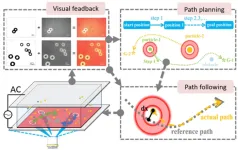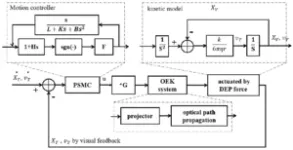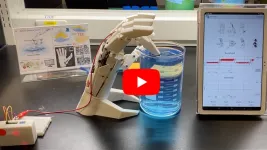A research paper by scientists at the Beijing Institute of Technology proposed an automated manipulation method for transporting microparticles actuated by optoelectronic tweezers (OETS).
The new research paper, published in the journal Cyborg and Bionic Systems, developed a dynamic control framework for synchronously discretized manipulation of multiple microparticles. Differentiated motion decisions are formulated for each micro target based on the corresponding state and environmental information in real time, so that all controlled targets can reach their goal positions safely and accurately. The motion of microparticle is controlled through dynamic modulation of virtual electrodes in OET Manipulation system to follow the desire trajectory, which is based on the dynamic decision from path planner.
“Among various robotic micro-manipulation techniques, OETs has received widespread attention due to its superiority in terms of massively parallel manipulation.” stated study author Huaping Wang, a professor at the Beijing Institute of Technology. In optoelectronic tweezers system, programmable virtual electrode (especially in the local nonuniform electric field) is generated by irradiating the light patterns on the photoconductive layer, on which the micro-objects are driven by dielectrophoretic force. The shape, size, number and position of virtual electrodes can be dynamic modulated so that the position, velocity and direction of micro-targets are under control. With the native features of both parallel actuation and independent control, the mechanism of ODEP is a significant tool for many biological micromanipulation tasks with the demands for high flexibility and efficiency (such as cell trapping, screening, and analysis). However, the trajectory of the virtual electrode has been planned in advance or even manually controlled in most OET control systems, which is insufficient to ensure the stability and efficiency in an environment with potential collision risk. “The challenge in simultaneous transport of microparticles with different types (including cells) in the collision-prone liquid environment is our main focus.”, said Wang.
The aforementioned control framework based on optoelectronic tweezers system consists of three main parts: visual-feedback module, path planner and motion controller. Among them, the visual-recognition algorithm provides environment information and target state for the latter two modules; according to the global optimization model, the path planner develops the local optimal path step-by-step based on the real-time information; and the error of path following is dynamically limited by motion controller. “The performance of path planner is the key to successfully implement the synchronously discretized manipulation.”, emphasized Wang.
To improve the efficiency of multi-particle transport as much as possible, researchers proposed an improved goal assignment method based on Hungarian method. Apart from the Euclidean distance, the cost function also includes the extra detour distance and the potential loss for recapture after escape of target. For collision avoidance, a dynamic path planner based on POMDP algorithm is designed to determine the optimal motion policies for all individual particle in each control period. There are errors in the observation information obtained at the beginning of a decision period caused by environmental interferences such as Brownian motion and fluid perturbations. Therefore, the research team model this uncertainty in the form of a probability distribution. In addition, a two-level priority system is established to revise the motion decision for avoiding potential collision of multiple target microparticles.
In terms of path following, researchers established and analyzed the kinematics and dynamical model of microparticle actuated by optoelectronic tweezers. Then a controller based on proxy-based sliding mode control method was designed and optimized for resisting disturbance interference, reducing tracking error, and realizing path following finally.
To verify the effectiveness of the proposed control framework, researchers carried out transport experiments with polystyrene (PS) microspheres and 3T3 cells. An extreme experiment with two groups of particles moving towards each other was designed to test the robustness of the algorithm. Rendezvous and separation of particles were accomplished by staggered advancing with a small circumvention cost and arranged in a triangular and trapezoidal distribution pattern at goal positions. In addition, experiments of transporting cells to designated positions in specific patterns are performed as a preliminary attempt of cell patterning, which indicated the feasibility and potential of applying the mentioned methods to biomedical studies.
As a novel scheme of parallel manipulation with independent control, the synchronously discretized manipulation method based on optoelectronic tweezers holds great promise for facilitating the efficiency and flexibility of multiple biomedical tasks. “Apart from cell patterning tasks, we will apply this manipulation methods in more scenarios in biomedical research in the future work, such as studies of cell-cell interaction, analysis of cell culture condition, cell assembly for reconstruction of artificial issues, etc.”, said Wang.
Authors of the paper include Jiaxin Liu, Huaping Wang, Menghua Liu, Ran Zhao, Yanfeng Zhao, Tao Sun, and Qing Shi.
National Key R&D Program of China; National Natural Science Foundation of China
The paper, " POMDP-Based Real-Time Path Planning for Manipulation of Multiple Microparticles via Optoelectronic Tweezers," was published in the journal Cyborg and Bionic Systems on November 3, 2022, at DOI: https://doi.org/10.34133/2022/9890607
Reference
Authors: Jiaxin Liu,1 Huaping Wang,2 Menghua Liu,1 Ran Zhao,1 Yanfeng Zhao,1 Tao Sun,3 and Qing Shi4
Title of original paper: POMDP-Based Real-Time Path Planning for Manipulation of Multiple Microparticles via Optoelectronic Tweezers
Journal: Cyborg and Bionic Systems
DOI: 10.34133/2022/9890607
Affiliations:
1 Intelligent Robotics Institute, School of Mechatronical Engineering, Beijing Institute of Technology, Beijing 100081, China
2 Key Laboratory of Biomimetic Robots and Systems (Beijing Institute of Technology), Ministry of Education, Beijing 100081, China
3 School of Medical Technology, Beijing Institute of Technology, Beijing 100081, China
4 Beijing Advanced Innovation Center for Intelligent Robots and Systems, Beijing Institute of Technology, Beijing 100081, China
A brief introduction about yourself.
About Dr. Huaping Wang:
Huaping Wang is Professor of Beijing Institute of Technology (BIT), the awardees of 2022 excellent young scientist fundation of NSFC. His research interests include micromanipulation, biofabrication, 4D printing, tissue engineering, intelligent microrobot, and biomaterials. Up to now, he has published over 40 SCI papers in Science Advances, Nature Communications, IEEE Transactions on automation science and engineering, IEEE/ASME Transactions on Mechatronics, Biofabrication, ACS Applied Materials & Interfaces and other journals.
Personal Homepage: https://smen.bit.edu.cn/sztd/szms/znjqryjs/b101008.htm
END




